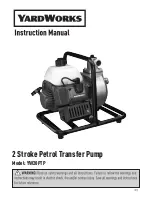
Installation
8
3A6938D
Plumbing
Install a fluid shutoff valve (D) between the mix tank (A)
and the pump (F).
When using a stainless steel pump, use stainless steel
plumbing to maintain a corrosion-resistant system.
Flush Before Using Equipment
The equipment was tested with lightweight oil, which is
left in the fluid passages to protect parts. To avoid con-
taminating your fluid with oil, flush the equipment with a
compatible solvent before using the equipment. See
Flushing the Fluid Supply Lines
Accessories
Install the following accessories in the order shown in
F
. 1, page 6, using adapters as necessary.
Fluid Line
•
Fluid shutoff valve (D):
shuts off fluid flow.
•
Fluid filter:
with a 60 mesh (250 micron) stainless
steel element to filter particles from the fluid as it
leaves the pump.
•
Fluid drain valve (N):
required in your system, to
relieve fluid pressure in the hose and gun.
Air Line
•
Second bleed-type air valve (H):
isolates air line
accessories for servicing. Locate upstream from all
other air line accessories.
•
Air line filter (K):
removes harmful dirt and mois-
ture from compressed air supply.
•
Pump air regulator (L):
to control pump speed and
outlet pressure. Locate close to the pump.
•
Bleed-type master air valve (M):
required in your
system to relieve air trapped between it and the air
motor when the valve is closed.
NOTICE
To prevent a bellows failure in a sealed 4-ball pump:
•
Do not exceed fluid inlet pressure of 15 psi (0.1
MPa, 1.0 bar).
•
Do not use a ball check pump on the inlet side of
this pump.
•
Do not use a suction tube with a check valve on
the inlet side of this pump.
Trapped air can cause the pump to cycle unexpect-
edly, which could result in serious injury from splash-
ing or moving parts. Be sure the valve is easily
accessible from the pump and located downstream
from the air regulator. Be sure the air bleed hole
points away from the operator.
To help prevent fluid over pressurization, do not
exceed the maximum air inlet pressure rating to the
air motor (see page 27). If you can apply more than
the maximum air input pressure to the system, install
a safety relief valve between the bleed-type master
air valve and the air motor. The safety relief valve
must be set to open if the air inlet pressure to the
motor exceeds the motor rating.









































